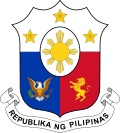| Municipalities of the Philippines | |
|---|---|
 Municipalities of the Philippines in white | |
| Category | Town (Local government unit) |
| Location | Philippines |
| Number | 1,493 (as of June 30, 2024) |
| Possible status |
|
| Populations | 406 (Kalayaan) – 451,383 (Rodriguez) |
| Areas | 1.66 km2 (0.64 sq mi) for Pateros – 2,188.8 km2 (845.1 sq mi) for Sablayan |
| Subdivisions | |
| Cities and municipalities of the Philippines |
|---|
|
 |
|---|
A municipality [a] is a local government unit (LGU) in the Philippines. It is distinct from a city, which is a separate category of LGU. Provinces are subdivided into cities and municipalities, which in turn are divided into barangays (formerly barrios). As of June 30, 2024 [update] , there are 1,493 municipalities across the country. [1]
Contents
- History
- Responsibilities and powers
- Organization
- Duties and functions
- Income classification
- See also
- Notes
- References
- Sources
A municipality is the official term for, and the local equivalent of, a town , [2] the latter being its archaic designation, including in literal translations into Filipino and other Philippine languages. [3] [4] [5] [6] [7] Both terms are sometimes used interchangeably.
A municipal district is a defunct local government unit; certain areas were first created as municipal districts before later being converted into municipalities.
